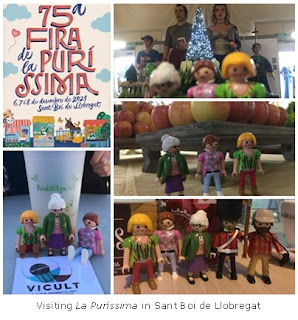Sant Boi de Llobregat is a city in the county of El Baix Llobregat, near Barcelona, in Catalonia, located on the banks of the Llobregat river. In 2019, it had 83,605 inhabitants.
The city is divided into six neighbourhoods, named barris in Catalan: Ciutat Cooperativa-Molí Nou, Marianao-Can Paulet, Barri Centre, Vinyets-Molí Vell, Camps Blancs-Canons-Orioles, and Casablanca.
It is bordered on the north by the towns of Santa Coloma de Cervelló and Sant Joan Despí and the village of Sant Climent de Llobregat; on the east by the town of Cornellà de Llobregat; on the west by Viladecans; and on the south by El Prat de Llobregat and the Mediterranean Sea, via a narrow southward salient.
Although the main business activity is trading, which is centred around the service sector, Sant Boi is also known for industrial activities, especially metallurgy.
Agriculturally, its mild climate and fertile waterlogged lands, located at the mouth of the Llobregat river, produce a wide variety of vegetables, including the famous Llobregat Delta artichokes.
The region offers three different artichoke varieties: white artichoke from Tudela, camús from Bretagne, considered to be the largest variety, and artichoke from Benicarló. Production is concentrated mostly in March, but products can be found in local markets throughout the year.
The finding of archaeological remains corresponding to Iberian colonies (VI-I bC) and to the Romans (I-V BC) -a noteworthy Roman bath is located near the river- suggests that Sant Boi was created in pre-Roman times.
As with most of the surrounding lands, from the 8th to the 11th century the town was controlled by the Moors, until their expulsion from Iberia during the Reconquista. The Moors called it Alcalà, which means castle, due to the existence of a hillock from where the river and the valley were dominated. The town's current name is derived from the name of Saint Baudilus, known as Boi or Baldiri in Catalonia.
During the Middle Ages, the village progressively grew, expanding from the castle's surroundings to adjacent zones. A baroque-style church was built during the 16th century. The growth continued in the following centuries, giving rise to numerous masies, typical Catalan agricultural country houses, near the river and fertile lands. By the end of the 19th century, Sant Boi was a village of nearly 5,000 inhabitants, with an economy driven mainly by agriculture.
In the early stages of the 20th century, industry arrived and subsequently flourished in Sant Boi, ranging from brick manufacturing to metalwork. With the end of the Spanish Civil War in 1939, there was a massive influx of immigrants from many parts of Spain. These new arrivals consisted mostly of people from villages and small towns. They were searching for jobs and career opportunities in the city of Barcelona, since it was stimulated by the regrowth of Catalan industry in post-war Spain.
The population rose from 10,000 people in 1940 to 65,000 in 1975. This period is characterized by the construction of complete quarters (Casablanca, Camps Blancs, and Cooperativa) for the housing of immigrants.
Sant Boi is now a town with more than 80,000 inhabitants, with well-established industrial and service sectors, and good cultural and recreational offerings.
More information: Turisme Baix Llobregat
The Fira de la Puríssima is one of the oldest fairs in Catalonia, which is held annually in Sant Boi de Llobregat. It takes place on 6, 7 and 8 December in several streets and other emblematic spaces of the town of Sant Boi de Llobregat with about 52,000 m2 of fairgrounds, 11,900 m2 of exhibition space and more than 480 exhibitors, which generate an economic impact of approximately 5 million euros.
The roots of the Fair can be found in the exhibition of apples that began to be held on 12 and 13 July 1931 on the floor of the old municipal library, and where the first was also held fruit set competition.
In 1947, the seasonal fruit exhibition was discontinued in the summer months and became a fair and exhibition of plants, fruit trees and ornamentation on December 8 of the same year. It was not until 1956 that the name Fira de la Puríssima was first adopted, but made Spanish by the imposition of the Franco dictatorship.
At the end of the year 1960, the local magazine Vida Samboyana collected quite critical writings with the Tour where it was pointed out that it had gone into decline and that, in order to trace it back, the collaboration of the whole population was needed: individuals and entities.
In November 1961, the creation of a Board of Trustees was announced, which, with greater financial availability as a result of the participation of the local administration, should ensure the good organization and development of the Fair. This, encouraged by a wide range of advertising, multiplied in relation to the critical editions of previous years.
Another remarkable date was the 1967 edition which was used to inaugurate the new Sant Jordi market which came to meet the demand of a large sector of the population, newly established. The Fair would reach its 26th edition in 1971. The Board of Trustees revived an old initiative and instituted a Poster Contest which was won by local artist Maria Dolors Villadelprat.
The current poster has been made by the local artist Iván Castro.
More information: Catalunya
which we as a society reflect on who we are,
where we've been, where we hope to be.
Wendell Pierce

No comments:
Post a Comment